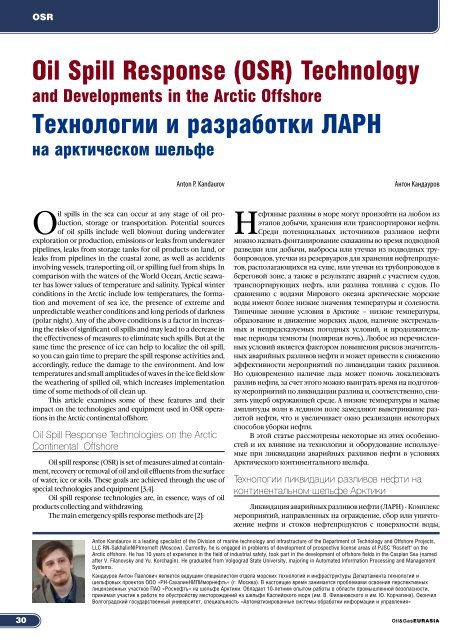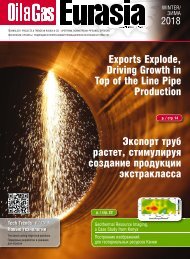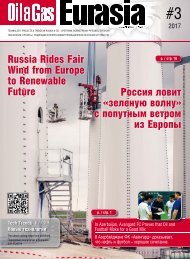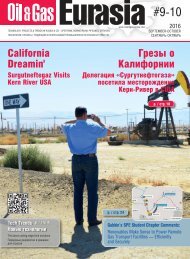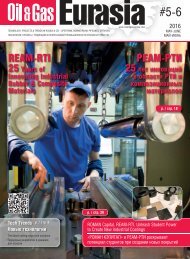Create successful ePaper yourself
Turn your PDF publications into a flip-book with our unique Google optimized e-Paper software.
OSR<br />
Oil Spill Response (OSR) Technology<br />
and Developments in the Arctic Offshore<br />
Технологии и разработки ЛАРН<br />
на арктическом шельфе<br />
Anton P. Kandaurov<br />
Антон Кандауров<br />
Oil spills in the sea can occur at any stage of oil production,<br />
storage or transportation. Potential sources<br />
of oil spills include well blowout during underwater<br />
exploration or production, emissions or leaks from underwater<br />
pipelines, leaks from storage tanks for oil products on land, or<br />
leaks from pipelines in the coastal zone, as well as accidents<br />
involving vessels, transporting oil, or spilling fuel from ships. In<br />
comparison with the waters of the World Ocean, Arctic seawater<br />
has lower values of temperature and salinity. Typical winter<br />
conditions in the Arctic include low temperatures, the formation<br />
and movement of sea ice, the presence of extreme and<br />
unpredictable weather conditions and long periods of darkness<br />
(polar night). Any of the above conditions is a factor in increasing<br />
the risks of significant oil spills and may lead to a decrease in<br />
the effectiveness of measures to eliminate such spills. But at the<br />
same time the presence of ice can help to localize the oil spill,<br />
so you can gain time to prepare the spill response activities and,<br />
accordingly, reduce the damage to the environment. And low<br />
temperatures and small amplitudes of waves in the ice field slow<br />
the weathering of spilled oil, which increases implementation<br />
time of some methods of oil clean up.<br />
This article examines some of these features and their<br />
impact on the technologies and equipment used in OSR operations<br />
in the Arctic continental offshore.<br />
Oil Spill Response Technologies on the Arctic<br />
Continental Offshore<br />
Oil spill response (OSR) is set of measures aimed at containment,<br />
recovery or removal of oil and oil effluents from the surface<br />
of water, ice or soils. These goals are achieved through the use of<br />
special technologies and equipment [3,4].<br />
Oil spill response technologies are, in essence, ways of oil<br />
products collecting and withdrawing.<br />
The main emergency spills response methods are [2]:<br />
Нефтяные разливы в море могут произойти на любом из<br />
этапов добычи, хранения или транспортировки нефти.<br />
Среди потенциальных источников разливов нефти<br />
можно назвать фонтанирование скважины во время подводной<br />
разведки или добычи, выбросы или утечки из подводных трубопроводов,<br />
утечки из резервуаров для хранения нефтепродуктов,<br />
располагающихся на суше, или утечки из трубопроводов в<br />
береговой зоне, а также в результате аварий с участием судов,<br />
транспортирующих нефть, или разлива топлива с судов. По<br />
сравнению с водами Мирового океана арктические морские<br />
воды имеют более низкие значения температуры и солености.<br />
Типичные зимние условия в Арктике – низкие температуры,<br />
образование и движение морских льдов, наличие экстремальных<br />
и непредсказуемых погодных условий, и продолжительные<br />
периоды темноты (полярная ночь). Любое из перечисленных<br />
условий является фактором повышения рисков значительных<br />
аварийных разливов нефти и может привести к снижению<br />
эффективности мероприятий по ликвидации таких разливов.<br />
Но одновременно наличие льда может помочь локализовать<br />
разлив нефти, за счет этого можно выиграть время на подготовку<br />
мероприятий по ликвидации разлива и, соответственно, снизить<br />
ущерб окружающей среде. А низкие температуры и малые<br />
амплитуды волн в ледяном поле замедляют выветривание разлитой<br />
нефти, что и увеличивает окно реализации некоторых<br />
способов уборки нефти.<br />
В этой статье рассмотрены некоторые из этих особенностей<br />
и их влияние на технологии и оборудование используемые<br />
при ликвидации аварийных разливов нефти в условиях<br />
Арктического континентального шельфа.<br />
Технологии ликвидации разливов нефти на<br />
континентальном шельфе Арктики<br />
Ликвидация аварийных разливов нефти (ЛАРН) - Комплекс<br />
мероприятий, направленных на ограждение, сбор или уничтожение<br />
нефти и стоков нефтепродуктов с поверхности воды,<br />
Anton Kandaurov is a leading specialist of the Division of marine technology and infrastructure of the Department of Technology and Offshore Projects,<br />
LLC RN-SakhalinNIPImorneft (Moscow). Currently, he is engaged in problems of development of prospective license areas of PJSC "Rosneft" on the<br />
Arctic offshore. He has 10 years of experience in the field of industrial safety, took part in the development of offshore fields in the Caspian Sea (named<br />
after V. Filanovsky and Yu. Korchagin). He graduated from Volgograd State University, majoring in Automated Information Processing and Management<br />
Systems.<br />
Кандауров Антон Павлович является ведущим специалистом отдела морских технологий и инфраструктуры Департамента технологий и<br />
шельфовых проектов ООО «РН-СахалинНИПИморнефть» (г. Москва). В настоящее время занимается проблемами освоения перспективных<br />
лицензионных участков ПАО «Роснефть» на шельфе Арктики. Обладает 10-летним опытом работы в области промышленной безопасности,<br />
принимал участие в работе по обустройству месторождений на шельфе Каспийского моря (им. В. Филановского и им. Ю. Корчагина). Окончил<br />
Волгоградский государственный университет, специальность «Автоматизированные системы обработки информации и управления»<br />
30 Oil&<strong>Gas</strong>EURASIA


